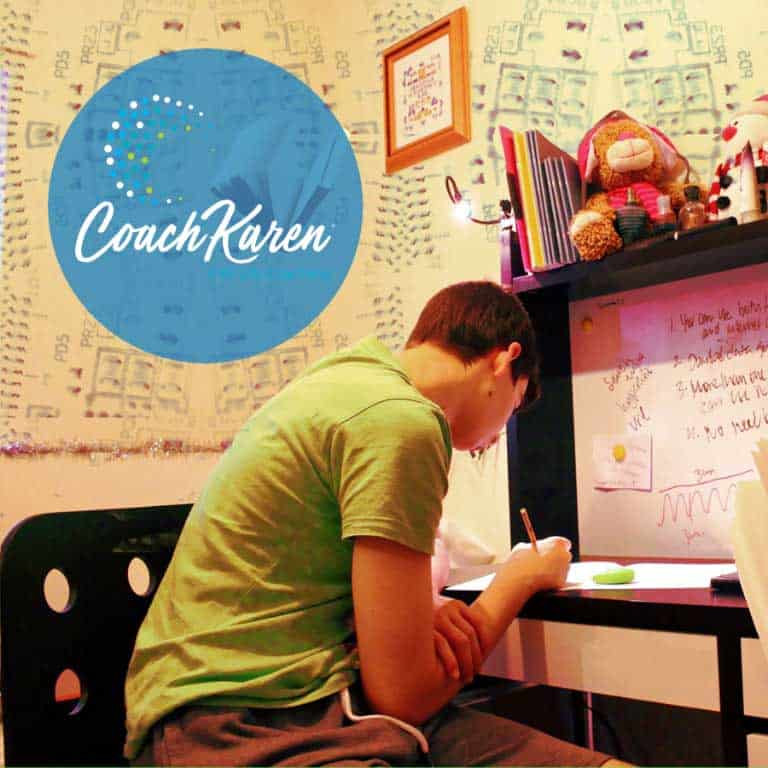
“The irony of a parent and child relationship is, that at any given moment, you never know who is teaching whom.” ~ Linda Poindexter
Having helped raise five children of my own and coaching teenagers, I’ve witnessed various parent-child dynamics over the decades. From helicopter parents to free-range parents, there is always a point when the child is going to ask for more autonomy than the adult is ready to give.
It’s not uncommon for me to get a call from a distraught parent crying, “I just don’t know what happened to my dear, sweet Susie! One minute she gives me a big hug and tells me she loves me, and the next she slams the bedroom door in my face telling me I’m meddling in her life. What’s going on?”
Other parents’ struggles are different but have some of the same root causes. Like an eight-year-old boy asking for more attention when his mom’s around her new boyfriend, or a daughter leaving for college when there is elevated tension between her and her parents.
There have long been studies exploring and examining child development from the parents’ perspective, especially the transitions surrounding emerging adulthood. Many of these incidents and behaviors are manifested in the difficulties parents have in ‘letting go’ of their grown‐up children, and in acknowledging their developing autonomy and freedom.
VALUES DEVELOPMENT
From birth, parents demonstrate to their children what is important in their lives and bestow their values upon them. As they grow, children continue to develop their values, but their influences and their ability to think for themselves begins to inform what they value most.
Sociologist Morris Massey describes three major periods during which values are developed – Imprint, Modeling, and Socialization.
The Imprint Period
During the first seven years of their lives, children’s brains are like sponges. They absorb everything around them and accept much of it as true, especially when it comes from their parents. Critical during this stage is learning a sense of right and wrong, good and bad.
The Modeling Period
Between the ages of eight and thirteen, children copy people. Most often they model themselves after their parents, but other important people in their lives can influence them as well. Rather than blindly accepting the values they see demonstrated around them, they try them on to see which ones work for them. At this age, children may be influenced by systems such as religion or by teachers and other youth leaders, like camp counselors or coaches.
The Socialization Period
Between the ages of thirteen and twenty-one, teenagers and young adults are very largely influenced by their peers. While developing as individuals, they look for ways to get away from the earlier structured programming of parents, religion, and school. Instead, they naturally turn to people who seem more like themselves. Other influences at these ages include the media, especially those parts which seem to resonate with the values of our peer groups.
This is also the stage in which I describe the Two I’s – Identity and Independence. “Who am I (as similar or different from what others tell me I am)?” and “I want to do it myself!” This is the final and longest period of developing their values. So, it makes sense that they widen their influence.
NOTE: Keep in mind, these are generalizations of development. I also had a child who, as soon as he could talk, decided everything was a point of negotiation.
PARENT-CHILD INTERACTION DURING DEVELOPMENT
Understanding the child’s natural development is only half the picture. Parents watch and influence these values through a different lens, and a worldview that eventually must negotiate “letting go.”
Along the way, parents give what advice they can. Their goal should be to promote as much individualism and genuine thought as possible. But sometimes, parents do need to set limits. Three major areas of contention are:
● Clothing choices
● Driving
● Going to School
Clothing Choices
If you think of this from the perspective of influence, a young child in the Imprint Period may be more open to wearing the clothing the parent picked out for them. The tweens in the Modeling Period may push back on a parent who tries to dictate their clothing choices. In the Socialization Period, most children develop more of an individual taste and seek out the influence of peers and the media.
As a parent, provide guidelines and allow your child to develop their own sense of style. This can be one of the simplest ways to support their individuality. However, if you feel a child is straying too far from what you feel is acceptable: 1) test your sense of “acceptability” with someone else, and 2) lean on outside sources to provide guidelines.
A great benchmark to use may be the schools themselves. Many schools have their own clothing guidelines such as:
● Not wearing any gang- or weapon-related clothing
● No droopy pants
● No spaghetti strap tanks for girls
● No shorts or skirts shorter than your fingertips on your thighs
My youngest daughter was sent home from school one day for taking off her sweater and exposing her spaghetti strap top. She learned her lesson, and that came straight from school with no parental corrections needed.
My middle son had a sweatshirt that he loved, but it was borderline offensive and against school guidelines. Ignoring our conversations about whether he could wear it to school, he still wore it to school. His response was “Well, nobody stopped me at school.”
In this case, we chose to take the sweatshirt from him. Since the sweatshirt was inappropriate, he just hadn’t been caught wearing it at school, we had to step in. Now, as an adult, we may gently remind him to iron a wrinkled shirt but allow him to have his own sense of clothing style.
Driving
Lucky for parents, children don’t start driving until the Socialization Period. However, don’t let this lull you into a false sense of security. Their driving style is heavily influenced by the manner in which they have experienced during imprinting and modeling, up until they’re sixteen.
In short, if parents speed, talk on the cell phone, don’t wear a seatbelt, or display negative attitudes towards law enforcement while they drive, these actions and beliefs affect the values our children use to develop their own driving style.
In addition to overall safety, this is one more reason to be good drivers when in the car with our children. They will model more what we DO, and less what we SAY.
Having raised 5 children, with the youngest going through the driving process right now, I will tell you it can be nerve racking! More than anything, we want our children to be safe. Before handing the keys over to your child, it is critical to establish specific ground rules on the use of the vehicles. Parents must emphasize that driving is a privilege, and it can be revoked.
My point here is also about “letting go.” This is often one of the biggest steps in establishing independence, not just in the child’s ability to expand their geography, but in their taking on a much deeper responsibility. Parents must supply the opportunity to show that they are up to the challenge.
In other words, if your child is 21-years-old, has been driving for the last 5 years with no tickets or accidents, lives on their own, and you are still monitoring their use of the car, you should consider reassessing your sense of “letting go.”
School Choices
During the Imprinting Period, parents have total control over their children’s school choices. Obviously, a child should have some say in exploring different extracurricular interests, but the school choice falls wholly on the adult.
When it comes time to middle and high school, there may be more choices to consider. In particular, if a child has specific talent in music or science, they may want to consider exploring those talents further in schools that cater to them or have better programs. Considering a child’s level of commitment and their desire should be a factor when deciding on a school.
Choosing a college is a far more complex process. What the child needs to know is that if parents are footing a portion of the expenses (which is highly likely), then this is a joint parent-child decision. In this age of huge tuition bills and enormous student debt, the burden of paying for higher education affects the whole family.
“Letting go” within this process requires your child having the opportunity to develop criteria for the colleges and universities they choose. It also means the child should complete their own college applications. If they can’t complete the process, how can a parent expect they can do the work that college requires?
Ultimately, we want a healthy parent-child relationship. As a parent, it is healthier for us and our children when we learn how to gradually “let go,” and allow our children to become successful independent young adults.
#loveyourself #enjoythelittlethingsinlife #lifecoach #mentor #successcoach #higherfrequency #believeinyourdreams #positiveparenting #enjoylifetoday #personaldevelopmentcoach #reducestress #lifecoachingforwomen #lifecoachingtips #careerplanning #levelupyourlife #lifecoaching101 #lifecoachformoms #teenlifecoaching #positiveparentingsolutions #Lifecoachingonline #fypcoachkaren #backtocollege #backtocollegelife #lettinggo #lettinggoquotes #lettinggoishard #allgrown #allgrownup #allgrownupnow #collegelife




